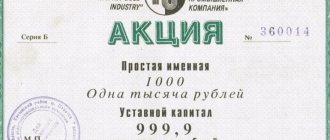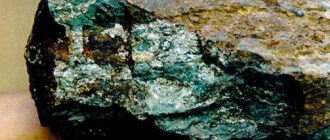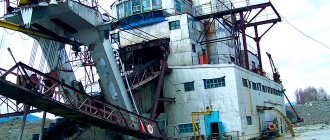The gold mining process is the extraction of gold by various methods from natural sources. Gold mining, depending on the chosen method, can include a whole range of works and processes: exploration of the territory for the presence of the desired metal, geological assessment, financing, development, direct extraction and delivery of finished cold ingots.
Gold mining in the world
Gold has been mined by people since time immemorial, as it is one of the most valuable elements existing on the planet. At the same time, the shortage of minerals is increasingly increasing, since this element in the natural environment is not renewable, and the acquisition of shares of gold mining companies is an increasingly popular area for investment. Currently, world reserves of the resource are estimated at approximately 55 thousand tons. Russia ranks second in terms of deposits (about 12.5 tons).
Trend for 2014–2015
| A country | year 2014 | 2015 | Trend |
| China | 450 t | 490 t | + 8.89% |
| Australia | 274 t | 300 t | + 9.49% |
| Russia | 247 t | 242 t | — 2.02% |
| USA | 210 t | 200 t | — 4.76% |
| Canada | 152 t | 150 t | -1.32% |
| Peru | 140 t | 150 t | +7.14% |
| South Africa | 150 t | 140 t | -6.67% |
The largest gold producing companies in the world are Barrick Gold (Canada), Newmont Mining (USA), AngloGold Ashanti (South Africa). Over the entire history of human development, the countries' leaders in gold mining have already processed over 100 thousand tons of gold for the following purposes:
- about 50% - jewelry;
- 1/3 is kept in banks as collateral (so it never loses its value);
- the rest went to production needs, where metal is used to ensure the operation of all kinds of equipment, etc.
However, gold mining in the world has not yet reached its maximum scale, since this metal can be recycled. Gold-bearing ores are the main place where gold is mined, which is contained there in sufficient quantities to make the extraction process economically feasible.
"Golden Story"
Gold is a metal that humanity became familiar with at least 6,500 years ago. The oldest treasure is considered to be found in the Varna necropolis, which is located in Bulgaria, and the items are dated back to 4600 BC.
Gold has played an important role throughout human history and is still considered a reliable investment. Currencies have come and gone, but it has remained a universal and stable standard for thousands of years.
Owning this metal has always been prestigious. Not only wealth was assessed by the amount of gold, but position in society also depended on it. This is still the case today.
It was gold that was often the cause of wars and crimes, but at the same time it played a huge role in the progress of mankind in general. On its basis, a monetary system began to take shape, cultural values and architectural masterpieces were created, which are priceless and still amaze everyone. Thanks to the desire to produce this metal, scientists obtained many chemical elements, and gold rushes helped to discover and develop new lands.
Gold mining and refining
First of all, it is worth noting that all the so-called “light gold” in the most accessible deposits has already been almost completely exhausted. The safest of the remaining mines are now considered to be in North America, however, even there the level of metal produced drops significantly every year. Since gold is inert, most of the metal is concentrated in the ore in its natural form. Various methods of gold mining and subsequent purification are used. The main methods are manual mining of alluvial gold and extraction in mines.
Basic traditional methods
Standard methods for extracting gold have been used for a very long time and are relevant now. Only earlier gold mining was practically carried out manually regarding the entire process, but now many tasks have been facilitated with the help of machines. Among the key sources are still gold-bearing rivers. Often, after heavy rains in winter and summer, floods form, washing rock into streams, and then mining gold with your own hands becomes relevant.
After this, gold falls into the seething water, which subsequently settles to the bottom of the rivers. It is obtained by an experienced gold miner using a wooden tray or other devices. But after a couple of weeks, this washed-up layer becomes covered with sand or overgrown with algae, which subsequently greatly complicates the process. That is why artisanal gold mining flourishes during the hot summer; it is very important to get the timing right.
This method of gold mining is very difficult - you have to work almost around the clock in the icy water of mountain rivers, and the results are not always happy.
Where and how experienced miners extract gold using the artisanal method: the widest part of the river bed is selected, it is good if a small other river flows into it and there should not be a strong current. The greatest chance of finding the desired prey is in mountainous areas. River rock can also be tested for gold content by the presence of quartz particles in its composition.
Mechanical means for working with gold-bearing rivers
The gold mining industry, based on extracting metal from rivers, uses a special mechanism for washing river rock - a dredge. This is a massive and noisy apparatus, the main purpose of which is the extraction of river gold. But the mechanism still does not exclude human work (workers sift the rock) and only facilitates part of the process by transporting rock from the bottom of the river inside the mechanism.
At the exit, the processed rock is dumped, where there is definitely no longer the required material.
So, gold can be mined quite realistically, the method is effective, however, there is a significant drawback - great harm to the environment and river ecology. The channels are subsequently very strongly deformed and rock dumps are observed everywhere.
Almagalmirovaniye
The basis of this method is mercury, since it is able to attract gold and envelop it. The extraction process itself includes the following steps:
- Mercury and rock are placed in a special container, after which it is shaken.
- Mercury envelops the gold and extracts it from the ore, settling at the bottom of the container. All excess remains on top and is then removed.
- The container is heated and the noble metal is separated from the mercury.
This method of gold mining was very common in the past and the reason for this is its low cost and efficiency. Nowadays it is practically not used due to the negative effects of mercury on the human body.
Modern techniques
Industrial gold mining is now actively carried out using heap leaching technology. Many gold mining countries use this method to extract the metal in economically viable quantities from low-grade and balanced ores, as well as small deposits. World gold mining began to reach new levels when heap leaching technology emerged:
- this method of gold mining can be implemented in just 1 year;
- this is the optimal period for a private gold miner;
- a great way to invest capital;
- within a year you will be able to hold bullion in your hands;
- when calculated per 1 kg of metal, the cost is lower than for traditional factory methods.
The method is much more modern and technologically less labor-intensive than artisanal gold mining, which is most often practiced in underdeveloped countries and in the absence of resources for other methods.
Steps of the production process using this technology
The method was invented with the participation of the Irgiridmed Institute and was first tested in 1991 in Kazakhstan. The production process, which includes gold mining technology using the heap leaching method, is implemented in several steps. Most often they look like this:
- preparation of ore material - crushing into small parts using specialized mills;
- passing rock through special sieves;
- pelletizing - allows you to eliminate the collection and sticking of ore into large fractions;
- formation of an ore stack - the ore is leached using cyanide solution (a very toxic and dangerous process);
- further, the ore should be extracted using the sorption method aimed at heavy metals - for this, an ion exchange resin or activated carbon is used, or the stage is carried out using the cementation method using metallic zinc;
- Now, in a galvanic bath, deposits are obtained on zinc deposits or the cathode.
Finally, by melting gold-bearing sediments, a master alloy is obtained, from which the remaining ore (tailings) is leached, and the land from which the rock was taken is reclaimed.
Golden bacteria
In Canada, scientists actually discovered bacteria that are capable of releasing gold from various solutions. Amazing, isn't it? For example, the bacterium Delftia acidovorans has a substance that releases precious metals from solution. And the reason is simple - she simply defends herself, protecting herself from gold ions, which are toxic to her. The second bacterium, Cupriavidus metallidurans, on the contrary, accumulates it inside itself.
Both were found in 2006 in “gold” mines. Canadian studies have shown that bacteria that accumulate gold manage to avoid poisoning due to their genetic nature.
More highly specialized techniques
Depending on where gold can be mined in a particular country, its location and the resource being mined, a number of more highly specialized techniques may be used. All of them are aimed at the industrial sector and require special equipment.
An exception is the use of a metal detector, however, this is also quite expensive equipment and each device is designed for its own operating conditions (land, water, etc.), which must also be taken into account.
Gravitational differentiation method
This procedure for gold-bearing rock is quite actively used by the modern gold mining industry. Everything is based on loading rocks onto trucks using large-scale excavators, transporting them to special mills where there are massive rotating drums. They crush the rock using large cast iron balls and then feed it into centrifuges. The heaviest fractions are carried to the edge and after repeated centrifugal spinning, the content of pyrite, an accompanying material, in the particles increases. Then this composition is washed many times and the heavy substance that has settled to the bottom is extracted from it.
Using a metal detector
Gold mining without special equipment can be done with your own hands using a metal detector. It is a mistake to believe that due to the low content of valuable metal in the waste ore, there is no point in taking out a metal detector and then processing a large amount of raw material in search of just one gram of precious metal. It is worth considering, however, that in the Earth’s crust the percentage of aurum (the name of the chemical element) is only 5 mg per 1 ton and therefore any of the methods with this approach can be considered useless.
A metal detector is a real way to mine gold and a valuable assistant for the miner, since rich and local deposits can still be found in the earth’s crust.
Their discovery is carried out by people with special education - geologists who know where, in theory, the most valuable areas can be located. There are so-called “ore nests” - the most gold-loaded parts of deposits that are already rich in metal. Here you can extract up to 1 kg of gold per ton of the Earth’s crust. Methods that include a metal detector are better for gold mining because the process is much faster and more efficient.
Using the flutter
Flotation is used by many countries that are leaders in gold mining. Although the method cannot be called uniquely aimed at gold mining, it significantly simplifies the task of how to extract the valuable metal. There is a similarity here with the dredge mechanism, however, the flutter is a more sensitive device, and it does not suck in rocks that easily get wet or are too light. Such gold mining mechanisms are derived from sulfide, copper or pyrite types of minerals.
Production involves the process of crushing ore, followed by pouring pine or other oil, everything is mixed, and particles from the mined metal will float up. Also in industry, air can be used, which will be passed through a mixture of water with crushed ore and some other reagents. When enough gold has been extracted, purification is carried out (usually using cyanidation).
Flotation
The flotation method is based on the unusual property of some rocks not to get wet, but to be enveloped in liquid particles and float on the surface like air bubbles. To do this, the rock is crushed and then filled with water or oil. After this, it is thoroughly mixed. In industrial mining, air, water or chemical elements are usually passed through this mixture.
The flotation machine is a series of chambers arranged in order with pulp discharge mechanisms. This is quite expensive, but more than pays for itself equipment, used by many leading countries in the gold mining industry.
Production in the cold season
Most often, gold miners leave their peak work for the summer, but if you know where to look for the “yellow value”, then winter mining has its advantages. It turns out that in winter it will be much easier to remove valuable metal from water than in summer. The first thing a seeker will need in such conditions is skis, and definitely hunting skis. Skiing will require you to navigate the rocky terrain of the streams, but it is important to remember to avoid rivers that are not completely frozen. It will be very advisable to move closer to the rock.
Moreover, due to the fact that river levels drop in the winter, the treasured sparkle can even be found on the surface of the rock. Here it is important not to forget to take into your arsenal the appropriate tools to remove metal particles from the surface.
It is worth noting that you can find much more valuable metal on the rocks than in the sand in summer. The very first task that a winter gold miner faces is to correctly determine the route and area for searching for the yellow metal.
To summarize, it is necessary to emphasize the importance of economic calculations and analysis of the feasibility of a particular method for various conditions. In each country and location of the metal, conditions are completely different and therefore some suitable method for one case will be completely useless or unprofitable for another. The search for precious metal is an extremely labor-intensive and complex process, in which special knowledge and equipment are indispensable for guaranteed success.
Leaching
Leaching is most notable because it can produce metal even from rock that has a low gold content or has already been processed. Its operating principle is as follows:
- The mined gold rock is crushed into small particles, no larger than a grain of sand.
- A cyanide solution is added to the resulting mixture and stirred. From the resulting mixture, cyanide liberates gold from the rock and impurities.
- The liquid is pumped out, and the solid particles are sent to a special tank, where the remaining cyanide solution separates the remaining gold. Heavy particles settle.
- Zinc is added to the solution, starting the process of “cyanide leaching,” which allows you to isolate up to 98% of the gold. Quite a costly, but also pays off method.
However, the process does not end there yet. For subsequent purification, the gold is sent to the furnace, after being mixed with a special chemical mixture - flux. Heats up to a temperature of 1500 C°. The result is a noble metal with 80% purification from impurities.











